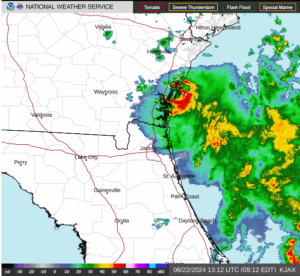Former Tropical Storm Helene strengthened to a hurricane northeast of the Yucatan Peninsula on Wednesday morning. At 11:00 a.m. EDT on Wednesday the center of Hurricane Helene was located at latitude 21.6°N and longitude 86.3°W which put the center about 500 miles (810 km) south-southwest of Tampa, Florida. Helene was moving toward the north-northwest at 10 m.p.h. (16 km/h). The maximum sustained wind speed was 80 m.p.h. (130 km/h) and there were wind gusts to 95 m.p.h. (150 km/h). The minimum surface pressure was 979 mb.
A Hurricane Warning is in effect for the portion of the coast from Anclote River to Mexico Beach, Florida. A Hurricane Warning is in effect for the portion of the coast from Cabo Catoche to Tulum, Mexico. That Hurricane Warning includes Cancun and Cozumel.
A Hurricane Watch is in effect for the portion of the coast from Anclote River to Englewood, Florida. The Hurricane Watch includes Tampa Bay. A Hurricane Watch is also in effect for the Cuban province of Pinar del Rio.
A Tropical Storm Warning is in effect for the portion of the coast from Anclote River to Flamingo, Florida. The Tropical Storm Warning includes Tampa Bay. A Tropical Storm Warning is in effect for the Lower and Middle Florida Keys west of Channel 5 Bridge. A Tropical Storm Warning is in effect for the Dry Tortugas. A Tropical Storm Warning is in effect for the portion of the coast from Mexico Beach to the Okaloosa/Walton County Line, Florida. A Tropical Storm Warning is in effect for the portion of the coast from Flamingo, Florida to South Santee River, South Carolina. A Tropical Storm Warning is in effect for Lake Okeechobee. A Tropical Storm Warning is in effect for the portion of the coast from Rio Lagartos to Cabo Catoche, Mexico. A Tropical Storm Warning was also in effect for the Cuban provinces of Artemisa, Pinar del Rio and Isle of Youth.
A Tropical Storm Watch is in effect for the portion of the coast from South Santee River to Little River Inlet, South Carolina.
A U.S. Air Force Reserve Hurricane Hunter aircraft found that former Tropical Storm Helene had strengthened to a hurricane on Wednesday morning. The inner end of a rainband wrapped around the northern, western and southern sides of the center of Helene’s circulation. An eye appeared to be forming at the center of Hellene. Bands of showers and thunderstorms were revolving around the core of Hurricane Helene. Storms near the core generated strong upper level divergence that pumped mass away from the hurricane. The removal of mass caused the surface pressure to decrease.
Winds to hurricane force extended out 25 miles (40 km) from the center of Hurricane Helene. Winds to tropical storm force extended out 275 miles (445 km) in the eastern side of Helene’s circulation. Winds to tropical storm force extended out 105 miles (165 km) in the eastern side of Hurricane Helene.
Hurricane Helene will move through an environment favorable for intensification during the next 24 hours. Helene will move over water where the Sea Surface Temperatures are near 30°C. It will move under the middle of an upper level ridge over the western Gulf of Mexico and the northwestern Caribbean Sea. The upper level winds are weak near the middle of the ridge and there will be little vertical wind shear. Hurricane Helene will intensify during the next 24 hours. Helene is likely to strengthen to a major hurricane by Thursday afternoon. Helene could intensify rapidly after an inner core with an eye and an eyewall is fully developed.
Hurricane Helene will move around the western end of a high pressure system over the western Atlantic Ocean. The high pressure system will steer Helene toward the north during the next 24 hours. On its anticipated track, Hurricane Helene will approach northern Florida on Thursday afternoon. Helene is likely to be a major hurricane when it reaches the northeastern Gulf of Mexico.
Hurricane Helene is likely to be a major hurricane when it approaches northern Florida on Thursday. Helene will bring strong winds and heavy rain to northern Florida. Heavy rain is likely to cause floods.
Flood Watches are in effect for Florida, eastern Alabama, and Georgia.
Helene could also cause a storm surge of up to 15 feet (4.5 meters) along portions of the west coast of Florida.
A Storm Surge Warning is in effect for the portion of the coast from Indian Pass to Flamingo, Florida. The Storm Surge Warning includes Tampa Bay and Charlotte Harbor.
A Storm Surge Watch is in effect for the portion of the coast from Indian Pass to Mexico Beach, Florida.

